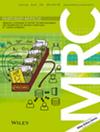HRMAS NMR for Studying Solvent-Induced Mobility of Polymer Chains and Metallocene Migration Into Low-Density Polyethylene (LDPE)
Abstract
HRMAS (high-resolution magic angle spinning) nuclear magnetic resonance (NMR) spectroscopy of low-density polyethylene (LDPE) affords 1H and 13C NMR spectra with superior resolution. For acquiring HRMAS NMR spectra, the polymer is first swollen with representative organic solvents. Then, the samples are measured with a conventional solid-state NMR spectrometer in the wideline mode or at the low spinning speed of 2 kHz. Anisotropic interactions like CSA (chemical shift anisotropy) and dipolar interactions are reduced due to the additional mobility of the polymer chains in the presence of the solvent within the polymer network. The combined effect of this mobility and MAS leads to signals with substantially reduced halfwidths as compared to classic MAS of the dry polymer. With HRMAS, all signals of the polymer become visible, and the spectra can be used for a quick and easy assessment of the polymer swelling behavior in diverse solvents. Being able to characterize polymers on the molecular level, and identifying the solvents that penetrate the polymer network best, enables the study of post-synthesis modifications of the polymers. It is demonstrated by paramagnetic HRMAS that the metallocene nickelocene (Cp2Ni) penetrates the LDPE network along with the solvent and is homogeneously dispersed in the polymer. SEM images prove that the structure of the polymer is not altered by the presence of a solvent and Cp2Ni. The impact of the paramagnetic Cp2Ni on the 1H signal halfwidth and T1 time of LDPE is studied. HRMAS allows a quick assessment of metal complexes regarding their ability to penetrate the LDPE network and therefore supports future studies of catalytic polymer degradation.


 求助内容:
求助内容: 应助结果提醒方式:
应助结果提醒方式:


